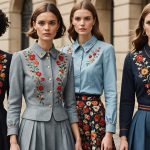Mastering Eco-Friendly Fashion: Your Ultimate Guide to Sustainable Style Choices
In the ever-evolving world of fashion, the shift towards sustainability is no longer a trend, but a necessity. As consumers become more aware of the environmental and social impact of their purchasing decisions, the demand for eco-friendly and sustainable fashion is on the rise. Here’s your comprehensive guide to making sustainable style choices that not only benefit the planet but also enhance your wardrobe.
Understanding Sustainable Fashion
Sustainable fashion is more than just a buzzword; it’s a movement that encompasses various aspects of the fashion industry, from the sourcing of materials to the production and distribution of clothing. Here are some key principles to keep in mind:
Have you seen this : Revamp Your Wardrobe: Harmonizing Classic British Tailoring with Modern Casual Chic
Ethical Manufacturing
Ethical manufacturing is a cornerstone of sustainable fashion. Brands like tentree and Fair Indigo prioritize fair wages, safe working conditions, and ethical production practices. For instance, tentree is committed to planting 10 trees for every item purchased, highlighting their dedication to environmental sustainability[1].
Eco-Friendly Materials
The choice of materials is crucial in sustainable fashion. Brands are increasingly using sustainable materials such as organic cotton, Tencel, hemp, and recycled fabrics. LA RELAXED, for example, uses GOTS-certified organic cotton, Tencel modal, and lyocell, along with deadstock fabrics and recycled buttons[1].
Also to see : Revamp Classic British Style: Elevate Your Wardrobe with Striking Embroidered Accents!
Quality and Longevity
Investing in high-quality, timeless pieces is essential for reducing waste. Fair Indigo’s commitment to creating clothes that last upwards of five years is a great example of this approach. Their Forever Organic Tees are made from organic Peruvian Pima cotton, ensuring both quality and sustainability[1].
Building a Sustainable Wardrobe
Creating a sustainable wardrobe is a journey, and here are some practical steps to help you get started:
Embrace Slow Fashion
Slow fashion encourages you to invest in durable, high-quality clothing rather than fast fashion. This approach not only reduces waste but also promotes a more mindful consumption of fashion. As 3RD ROCK suggests, embracing slow fashion means avoiding fast fashion, learning to mend or upcycle, and supporting sustainable clothing brands[3].
Capsule and Minimalist Fashion
A capsule wardrobe is a great way to reduce your environmental footprint. It involves having a limited number of versatile, high-quality pieces that can be mixed and matched to create multiple outfits. Minimalist fashion aligns with this concept, focusing on simplicity and reducing unnecessary purchases.
Second-Hand Shopping
Second-hand shopping is a booming trend, and for good reason. It reduces waste, supports sustainable consumption, and can be incredibly stylish. Platforms like ThredUP, eBay, and Vinted are making it easier than ever to find high-quality second-hand items. According to Good On You, the global second-hand market is expected to nearly double by 2027[5].
Sustainable Fashion Brands to Watch
Here are some sustainable fashion brands that are making a significant impact:
tentree
- Best For: Cozy, casual essentials
- Sustainability: WRAP, BSCI, SA8000, or Fair Trade certified; plants 10 trees for every item purchased
- Materials: Sustainable fabrics like Tencel, hemp, and organic cotton
- Size Range: XS–XXL
Fair Indigo
- Best For: Organic basics
- Sustainability: GOTS certified organic cotton, safe dyes, fair wages, artisan-made
- Materials: Organic Peruvian Pima cotton
- Size Range: XS–XL; up to US 18
Everlane
- Best For: Modern staple workwear pieces
- Sustainability: Transparent factories, no virgin plastic, organic and chemical-free fabrics, working towards net-zero emissions
- Materials: Fine fabrics in ethical factories
- Size Range: XS–XXL; up to US 20[1].
Table: Comparing Sustainable Fashion Brands
| Brand | Best For | Sustainability Credentials | Materials | Size Range |
|---|---|---|---|---|
| tentree | Cozy, casual essentials | WRAP, BSCI, SA8000, or Fair Trade certified | Tencel, hemp, organic cotton | XS–XXL |
| Fair Indigo | Organic basics | GOTS certified organic cotton, safe dyes | Organic Peruvian Pima cotton | XS–XL; up to US 18 |
| Everlane | Modern staple workwear pieces | Transparent factories, no virgin plastic | Fine fabrics in ethical factories | XS–XXL; up to US 20 |
| Reformation | On-trend sustainable clothing | Climate Neutral Certified, sustainable & regenerative fabrics | Sustainable and upcycled materials | XXS–3X; up to US 24 |
| LA RELAXED | Casual everyday wear | GOTS-certified organic cotton, TENCEL modal & lyocell | Deadstock fabrics, recycled buttons | XS–XXL |
The Role of Legislation and Industry Initiatives
Legislation and industry initiatives play a crucial role in driving sustainability in the fashion industry.
Fashion Weeks and Sustainability Guidelines
Copenhagen Fashion Week has set a precedent by requiring brands to follow sustainability guidelines to participate. This model could be adopted by other major fashion weeks, pushing brands to implement zero-waste policies and supply chain due diligence[5].
Government Regulations
The European Commission’s Ecodesign for Sustainable Products Regulation and the New York Fashion Act are examples of legislative efforts aimed at promoting sustainability in the fashion industry. These regulations can help standardize sustainability practices and prevent greenwashing[5].
Community and Brand-Led Sustainability
Building a community around sustainable fashion is essential for its success.
Brand-Led Sustainability
Brands need to prioritize brand building and create a cultural presence that resonates with consumers. As the Sustainable Fashion Forum notes, good intentions and sustainability credentials alone are not enough; brands must foster emotional ties with consumers through style, quality, and cultural relevance[4].
Community-Driven Engagement
Community-driven engagement is vital for sustainable brands. By fostering spaces for dialogue, creativity, and collaboration, brands can build trust and loyalty among consumers. Wearwell, for example, offers an annual membership with perks like free shipping and virtual styling sessions, supporting a community that values inclusivity and sustainability[1].
Practical Tips for a More Sustainable Wardrobe
Here are some practical tips to help you make more sustainable fashion choices:
- Read Clothing Labels: Pay attention to the materials and certifications (like GOTS or Fair Trade) when shopping for new clothes[3].
- Mend and Upcycle: Learn to mend your clothes and upcycle old items to extend their life[3].
- Choose Timeless Pieces: Invest in high-quality, timeless pieces that won’t go out of style quickly[1].
- Shop Second-Hand: Explore second-hand stores and online platforms for unique and sustainable finds[5].
- Avoid Fast Fashion: Steer clear of fast fashion by avoiding impulse buys and focusing on quality over quantity[3].
The Future of Sustainable Fashion
As we look ahead to 2025 and beyond, here are some trends and predictions that will shape the future of sustainable fashion:
Alternative Materials
The development of alternative materials is on the rise. With innovations in textile recycling and next-gen materials, the industry is moving towards more sustainable options. The Material Innovation Initiative reported that 144 companies were dedicated to researching and developing these materials in 2023, up from 95 in 2021[5].
Wider Animal Protections
There is a growing trend towards wider animal protections in fashion. Many brands have already dropped the use of fur, and by 2030, a significant number plan to ditch cruel wool. This shift is part of a broader movement towards more humane and sustainable practices[5].
Radical Collaboration
Radical collaboration among brands, suppliers, startups, and governments is necessary for meaningful progress in sustainable fashion. By pooling resources and expertise, the industry can address shared challenges more effectively and scale proven solutions[4].
Mastering eco-friendly fashion is a journey that requires awareness, commitment, and a willingness to make conscious choices. By understanding the principles of sustainable fashion, building a sustainable wardrobe, and supporting brands that prioritize sustainability, you can make a significant impact.
As Brittany Sierra from the Sustainable Fashion Forum aptly puts it, “Sustainable fashion cannot rely on aspirational claims or surface-level initiatives—it requires transparency, cultural relevance, and a willingness to own imperfections.” By embracing these principles, we can reshape the fashion industry to be more sustainable, equitable, and environmentally friendly.
So, the next time you’re thinking about adding a new piece to your wardrobe, remember that your choices have the power to make a difference. Choose sustainable, choose eco-friendly, and choose a style that not only looks good but also does good.










